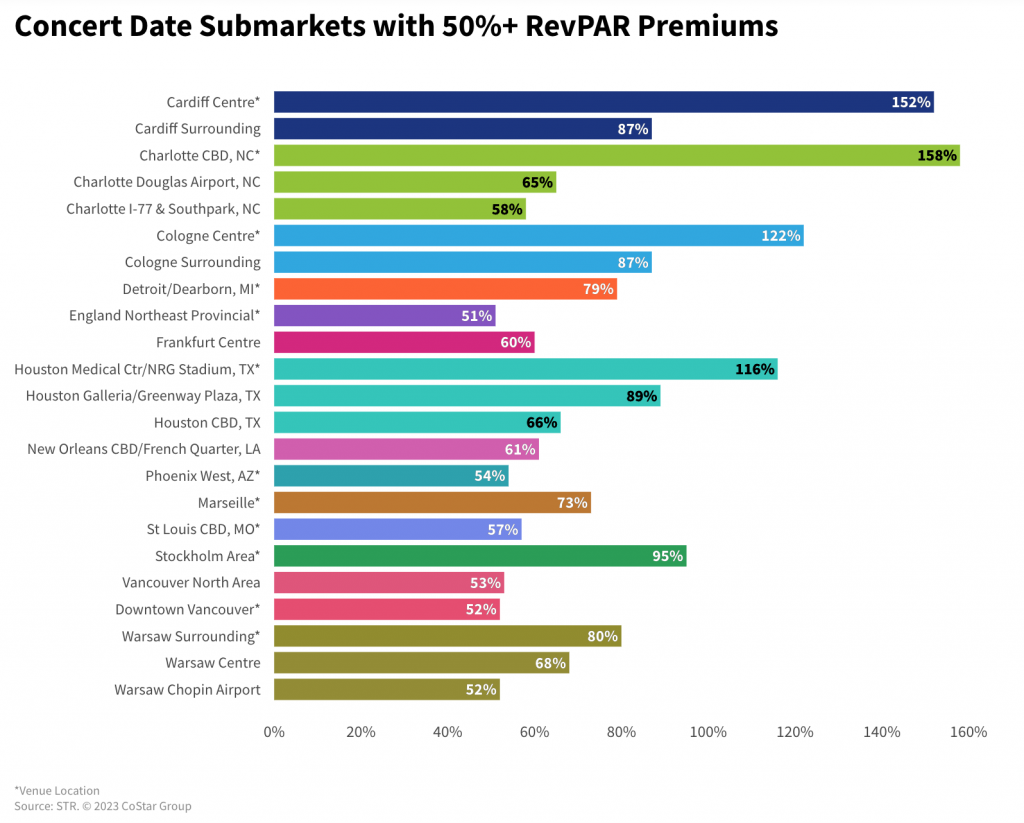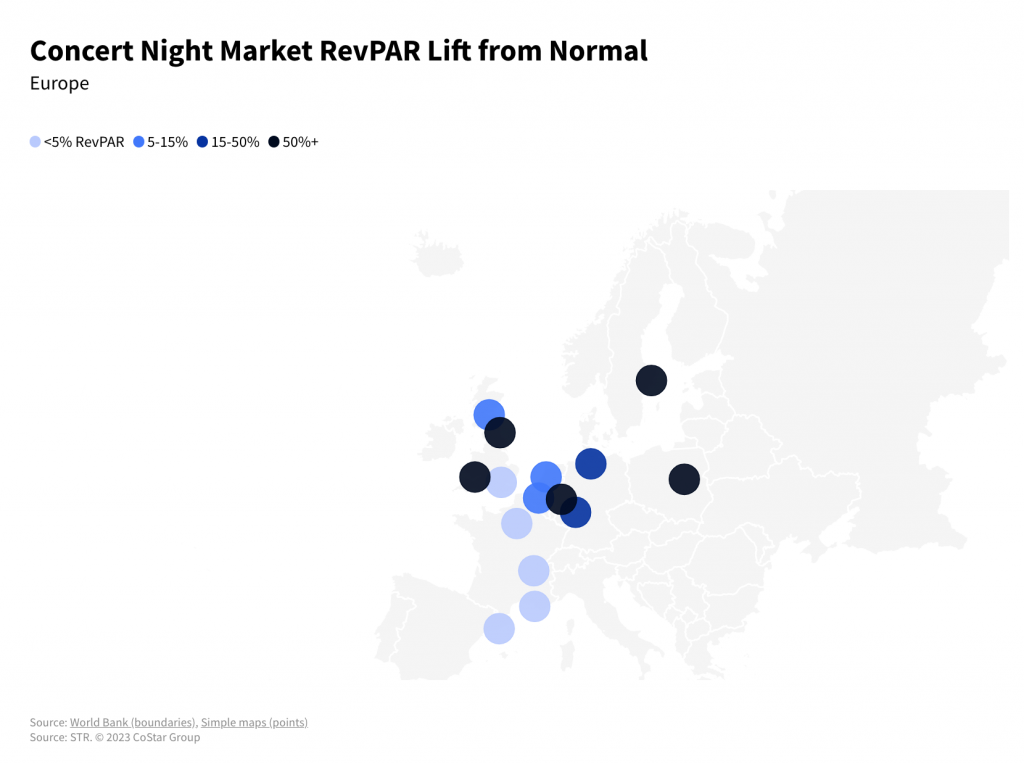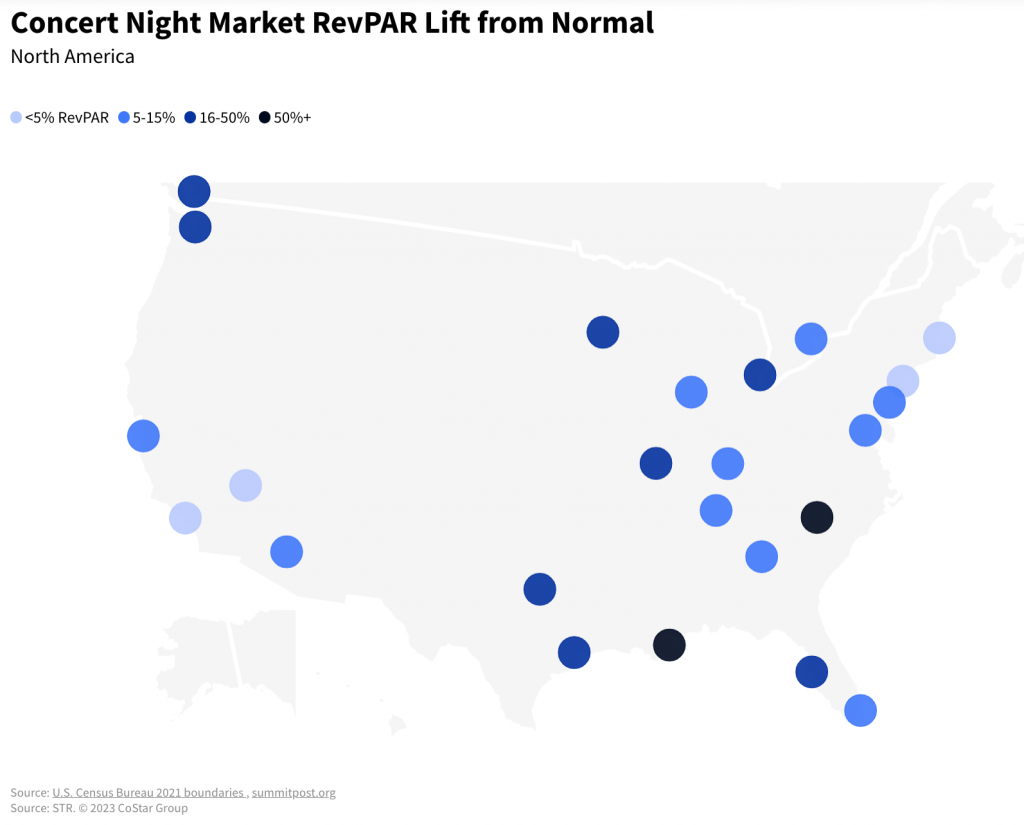Analysis by M. Brian Riley
Concerts and major events have always been important revenue opportunities for hotels, but 2023 has felt like the “year of the concert” with major tour generating headlines and lifting performance all over the world.
In the U.S., much of the attention went toward Taylor Swift’s The Eras Tour, which STR previously estimated added $208 million in U.S. room revenue. More recently though, there has been another female pop star rocking the economy – and in many markets, hotel performance.
Beyoncé’s Renaissance World Tour generated a projected U.S. economic impact of $4.5 billion, according to the New York Times. For context, that value was roughly the same as the amount generated by the 2008 Olympics in Beijing. The Times also noted that Beyoncé set a record for highest grossing solo female artist.
That level of impact of course piques the interest of hotel industry stakeholders as a performance lift for hospitality markets hasn’t been as obvious. Our analysis of hotel performance data showed a rather inconsistent impact market to market, which makes the market standouts the more “unique” focus rather than overall impact.
Methodology
Earlier this year, we showed a brief glimpse into performance actuals around Beyoncé’s tour stops in Europe in May and June. The European leg of the Renaissance World Tour ran from early May to late June with 22 shows in 15 cities. The North American leg of the Renaissance World Tour began shortly after the Fourth of July and concluded with a makeup show on 1 October, bringing the North America total to a SUMMER RENAISSANCE of 35 shows in 25 cities.
Only 12 of Beyonce’s 40 global stops hosted multiple shows: Amsterdam (2), Atlanta (3), Chicago (2), East Rutherford, NJ (2), Houston (2), Inglewood (3), Las Vegas (2), London (3), Stockholm (2), Toronto (2), Warsaw (2) and Washington, DC (2).
The analysis used the average of matched days in shouldering weeks as a performance baseline. Adjustments were made as necessary to account for outliers in the baselines. Financial metrics for each market represented U.S. dollars.
Standout markets
Cardiff, Wales, with a high occupancy baseline (92.0%) for the time around its host night of 17 May, managed to go even higher (than the key changes in “Love on Top”) at 95.7%. Average daily rate (ADR) in the market popped to $247 from a baseline of $106, driving a premium in revenue per available room (RevPAR) of $139 (or 141.8%), which was far and away the highest boost for any of the tour host markets.
Cologne, Germany, experienced massive occupancy (95.3%) compared to its baseline for the period (61.1%). That was the big contributor to an $80 RevPAR premium for the market.
The proximity of Seattle and Vancouver provided opportunity for the BeyHive in the Pacific Northwest to catch multiple shows in mid-September. Hotels in those cities ran almost identical occupancy levels on the nights Beyoncé performed: Vancouver at 93.6% on 11 September and Seattle at 93.7% on 14 September. Hotels in Vancouver picked up an $80 premium in RevPAR due to higher ADR of $277. Seattle’s ADR ($231) and RevPAR premium ($62) were a bit lower, although the latter was the best for any U.S. market.
Charlotte on 9 August posted much lower actual occupancy (81.9%) and ADR ($154), but the market’s RevPAR premium ($49) was HEATED during a lower performance time in the market.
Houston, Beyoncé’s hometown, and nearby New Orleans (another residence of Queen Bey), hosted concerts on 24 September and 27 September. New Orleans was higher in occupancy (74.7%), ADR ($167) and RevPAR premium ($41). While almost two and half times larger than New Orleans, the Houston market saw an appreciable occupancy boost above its normal (hottest weather) low-season baselines (to 67.5%) and market lift in ADR by $21 for a concert-night RevPAR premium of $25.
Roughly 20% of host cities saw performance come in lower than their respective baseline, but most were high inventory markets during a high performance season, such as London, Boston, Las Vegas and Los Angeles (with the shows in Inglewood).
Conclusion
The Renaissance World Tour included few multi-night stops and a fair number of dates (29 of 57) on weeknights—which are less accommodating for travel, especially once school was back in session. That likely meant that shows were filling up more with local attendees as opposed to the traveling “Yoncé” fan who requires accommodation. Thus, some markets popped, while others remained closer to normal demand trends.




